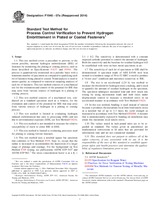Potřebujeme váš souhlas k využití jednotlivých dat, aby se vám mimo jiné mohly ukazovat informace týkající se vašich zájmů. Souhlas udělíte kliknutím na tlačítko „OK“.
ASTM F1940-07a(2014)
Standard Test Method for Process Control Verification to Prevent Hydrogen Embrittlement in Plated or Coated Fasteners (Includes all amendments And changes 9/17/2019).
Automaticky přeložený název:
Standardní zkušební metoda pro ověřovací proces kontroly s cílem zabránit vodíkové křehkosti v pokovené nebo potažené Spojovací
NORMA vydána dne 1.8.2014
Informace o normě:
Označení normy: ASTM F1940-07a(2014)
Poznámka: NEPLATNÁ
Datum vydání normy: 1.8.2014
Kód zboží: NS-52158
Počet stran: 9
Přibližná hmotnost: 27 g (0.06 liber)
Země: Americká technická norma
Kategorie: Technické normy ASTM
Kategorie - podobné normy:
Anotace textu normy ASTM F1940-07a(2014) :
Keywords:
coating, delayed failure, displacement control, EHE, fasteners, hydrogen embrittlement, IHE, incremental step load, loading rate, plating, steel, threshold, ICS Number Code 21.060.01 (Fasteners in general)
Doplňující informace
| Significance and Use | ||||||||||||||||||||||||||||||||||
|
5.1 This test method establishes a means to verify the prevention, to the extent possible, of IHE in steel fasteners during manufacture by maintaining strict controls during production operations such as surface preparation, pretreatments, and plating or coating. It is intended to be used as a qualification test for new or revised plating or coating processes and as a periodic inspection audit for the control of a plating or coating process. 5.2 Passing this test allows fasteners to be stressed in tension to the minimum specified tensile load in air with almost no possibility of time delayed fracture in air as a result of IHE from processing. If the amount of residual hydrogen is not sufficient to induce cracking or fracture in the specimen under worst case conditions, then it can be concluded that all of the lots of fasteners processed during that period will not have sufficient residual hydrogen from processing to induce hydrogen embrittlement of the fasteners under stress in air if the process remains in control, unchanged and stable. 5.3 If certified specimens with demonstrated sensitivity to IHE, processed with the fasteners, have a threshold ≥75 % of the incremental step load notched bend fracture stress, NFS(B)F1624, it is assumed that all fasteners processed the same way during the period will also pass any sustained load IHE test. |
||||||||||||||||||||||||||||||||||
| 1. Scope | ||||||||||||||||||||||||||||||||||
|
1.1 This test method covers a procedure to prevent, to the extent possible, internal hydrogen embrittlement (IHE) of fasteners by monitoring the plating or coating process, such as those described in Specifications F1137 and F1941. The process is quantitatively monitored on a periodic basis with a minimum number of specimens as compared to qualifying each lot of fasteners being plated or coated. Trend analysis is used to ensure quality as compared to statistical sampling analysis of each lot of fasteners. This test method consists of a mechanical test for the evaluation and control of the potential for IHE that may arise from various sources of hydrogen in a plating or coating process. 1.2 This test method consists of a mechanical test, conducted on a standard specimen used as a witness, for the evaluation and control of the potential for IHE that may arise from various sources of hydrogen in a plating or coating process. 1.3 This test method is limited to evaluating hydrogen induced embrittlement due only to processing (IHE) and not due to environmental exposure (EHE, see Test Method F1624). 1.4 This test method is not intended to measure the relative susceptibility of steels to either IHE or EHE. 1.5 This test method is limited to evaluating processes used for plating or coating ferrous fasteners. 1.6 This test method uses a notched square bar specimen that conforms to Test Method F519, Type 1e, except that the radius is increased to accommodate the deposition of a larger range of platings and coatings. For the background on Test Method F519 testing, see publications ASTM STP 5432 and ASTM STP 962.1.7 The sensitivity of each lot of specimens to IHE shall be demonstrated. A specimen made of AISI E4340 steel heat treated to a hardness range of 50 to 52 HRC is used to produce a “worst case” condition and maximize sensitivity to IHE. 1.8 The test is an accelerated (≤24 h) test method to measure the threshold for hydrogen stress cracking, and is used to quantify the amount of residual hydrogen in the specimen. The specimen undergoes sustained load and slow strain rate testing by using incremental loads and hold times under displacement control to measure a threshold stress in an accelerated manner in accordance with Test Method F1624. 1.9 In this test method, bending is used instead of tension because it produces the maximum local limit load tensile stress in a notched bar of up to 2.3 times the yield strength as measured in accordance with Test Method E8. A fastener that is unintentionally exposed to bending on installation may attain this maximum local tensile stress. 1.10 The values stated in inch-pound units are to be regarded as standard. The values given in parentheses are mathematical conversions to SI units that are provided for information only and are not considered standard. 1.11 This standard does not purport to address all of the safety concerns, if any, associated with its use. It is the responsibility of the user of this standard to establish appropriate safety and health practices and determine the applicability of regulatory limitations prior to use. |
||||||||||||||||||||||||||||||||||
| 2. Referenced Documents | ||||||||||||||||||||||||||||||||||
|
Podobné normy:
Historická
1.3.2014
Historická
1.4.2008
Historická
1.4.2013
Historická
1.11.2013
Historická
1.11.2011
Historická
1.5.2011
Odebírejte informace o nově vydaných normách ZDARMA:
Chcete pravidelně odebírat informace o nově vycházejících normách z celého světa a to zcela zdarma?
Přihlašte se k odběru. Vše je velice jednoduché a absolutně ZDARMA.
Na výběr máte vydavatele z celého světa.



 ASTM D5648-01(2014)..
ASTM D5648-01(2014).. ASTM D5649-01(2008)..
ASTM D5649-01(2008).. ASTM D5652-95(2013)..
ASTM D5652-95(2013).. ASTM E1685-13
ASTM E1685-13 ASTM F1136/F1136M-11..
ASTM F1136/F1136M-11.. ASTM F1137-11e1
ASTM F1137-11e1
 Cookies
Cookies
